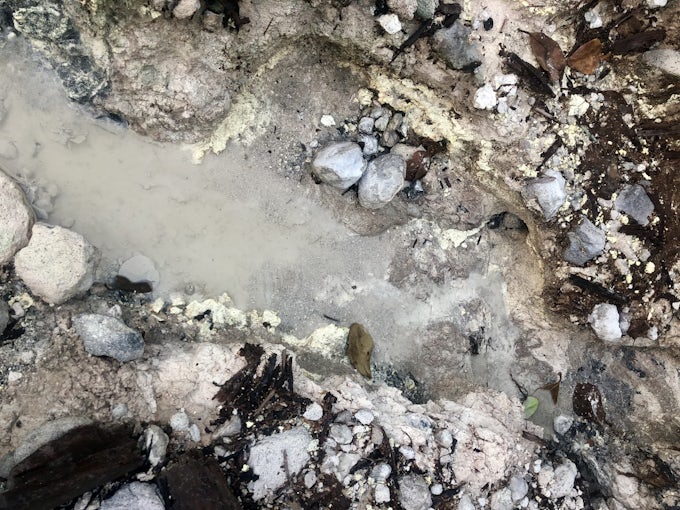In this text, Adiva is in conversation with Nyugen Smith and Minia Biabiany, where they explore the entanglements of life and history with territory and place, thinking through Caribbean epistemologies as a means to navigate these questions in the present.
Belle Île en Mer, Marie Galante, se ressemblent.
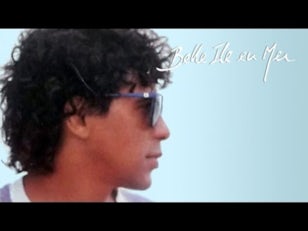
Like the Guadeloupian-French singer Laurent Voulzy01, I have inhabited the distance between French Atlantic shores and the beaches of Marigot, Dominica. My dialogue with the artists I talk to along the way is an attempt to craft out some kind of discursive site in the distance – to propose a possible set of relations within it, in which the artists speak to me, and they speak to each other, by way of me.
In 2014 I went to Dominica for the first time. I was longing for an existence lived as someone who knows where they come from. I was 23. I had not dared to go to Dominica before, as I did not feel like I had been invited to – and anyway, Dominica was not known.
Do you mean the Dominican Republic?
– No, Dominica. The island that no one knows about between the two French-speaking Caribbean islands, Guadeloupe and Martinique.
– Ah. Have you been?
– No, never. My father never took me there.
My journey involves three volcanoes, three reliefs seized in the oceanic distance. Montagne Pelée, at the north end of Martinique; La Grande Soufrière, on the island of Basse-Terre, in Guadeloupe; and the Cold Soufriere, in Dominica. These three active volcanoes, on neighbouring islands, are prominent features of their local contexts.
When I went to Dominica for the first time, I travelled via Martinique; later, my research would take me to Guadeloupe. I encountered the three volcanoes in different ways and at different times – through encounters with artists and their work, and through family and local connections – and they have offered entry points in my quest for knowing. In this sense the volcanic metaphor may offer a way to consider the seismic debris of life and history, their entanglement with territory and place, and how to navigate this in the present.

- Montagne Pelée: Nyugen Smith
In 2014, I went to the first Biennale Internationale de Martinique (BIAC). Biennales have this way of revealing territories to ‘international’ people like me. The BIAC was organised by the Regional Council of Martinique and the Campus Caribéen des Arts (the Martinican artistic studies university).
I discovered Nyugen Smith’s Untitled Boat No.1 after reaching the biennale’s international hall, hidden in the leafy, cloudy hills of Le Morne Rouge, north of Fort-de-France and just south from the Pelée volcanic mountain, which last erupted in 1902. Nyugen’s boat does not float on water. Instead, it stands on an isolated patch of soil, where its roots are. People and animals live off this soil, and the gloves attached to the hull of the boat appear to point to the collective labour that allowed it to stand.
The way I thought about Caribbean soil had been shaped by the tales told by my father about his birthplace. He told me that bush tea, coconut oil and sulphur from the volcano can cure anything. But in reality, I had been looking at my father looking at Africa. The Caribbean, in his eyes, could not be the final destination.
I met Nyugen Smith properly four years after my encounter with his work in Martinique, when I attended the conference ‘Black Portraitures: The Color of Silence’ at Harvard University. He was taking part in a panel. I found out more about his interdisciplinary artistic practice, and his interest in envisioning speculative futures for the Caribbean region that would draw on the specific relations Caribbean people have built with the territory. We stayed in touch, and we found time to talk about his work whilst I was doing research in Guadeloupe for my PhD. He had been working on his bundlehouse series, a concept he started developing in 2005, and which takes a variety of forms, from painting to installation and performance. Like Untitled Boat No.1, the bundlehouse places its focus on what has emerged out of the foundational displacement that characterises the Caribbean condition.

The way I thought about Caribbean soil had been shaped by the tales told by my father about his birthplace. He told me that bush tea, coconut oil and sulphur from the volcano can cure anything. But in reality, I had been looking at my father looking at Africa. The Caribbean, in his eyes, could not be the final destination.
I met Nyugen Smith properly four years after my encounter with his work in Martinique, when I attended the conference ‘Black Portraitures: The Color of Silence’ at Harvard University. He was taking part in a panel. I found out more about his interdisciplinary artistic practice, and his interest in envisioning speculative futures for the Caribbean region that would draw on the specific relations Caribbean people have built with the territory. We stayed in touch, and we found time to talk about his work whilst I was doing research in Guadeloupe for my PhD. He had been working on his bundlehouse series, a concept he started developing in 2005, and which takes a variety of forms, from painting to installation and performance. Like Untitled Boat No.1, the bundlehouse places its focus on what has emerged out of the foundational displacement that characterises the Caribbean condition.
I asked him about how he developed these works:
I started creating bundlehouses in 2005. It was a moment when I was thinking about people that have to rebuild their lives because of traumatic events, whether it’s natural disaster, or war, genocide. The bundlehouse also became a metaphor for people having to rebuild their lives from things that remain. 02
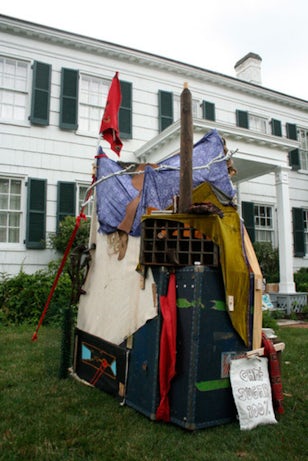
Nyugen told me that at the time he began creating bundlehouses, he was primarily thinking about the continent of Africa. When I asked him about connections he sees between the bundlehouses, colonialism, and maps, he told me that bundlehouses are disparaged objects, materials that have been discarded, seen as having no value. So, thinking about colonialism in places that have been divided by the colonizer, or “conquered”, they are the things that become these parts of a people that was broken apart, cast aside.’ And the bundlehouses function to (re)connect these elements: ‘How do they come back together, in relation to each other, how do they form social fabrics, methods and modes of resilience?’
I was very interested in his Bundlehouse: Borderlines map drawings, in which he merges various Caribbean islands together, such as Dominica and Bermuda, thereby contesting the solidity of the administrative and linguistic fragments inherited from colonialism that make up the region. He had began looking at maps in his work in 2012 when he was invited to do an exhibition at Seton Hall University. 03 They gave each artist these de-accessioned maps from the school library to make work with for an exhibition. He started producing topographical maps of imagined spaces, engaging with colonialism and the black diaspora.
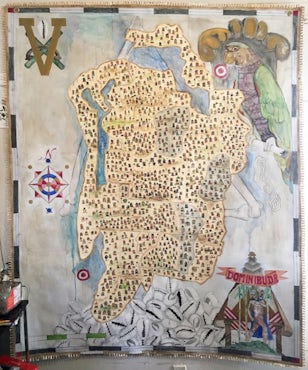
I had come across maps by colonial painters to document and administer new territories in the New World in the collections of the Dutch National Museum of World Cultures. In a 1844 map of Suriname by the Belgian plantation owner and draftsman Theodore Bray, borders, limits and an array of symbols, figures and sceneries are meant to present the Western viewer with information about the colonised place. 04 Early maps of America rendered uncharted territories visible to the metropolitan eye and set the conditions of their intelligibility. In Bray’s map, cartouches are superimposed onto a map and depict sceneries of life in Suriname, where Indigenous, Black and white subjects co-exist in a well-administered ensemble. Coming across this work, I was reminded of the BIAC’s stated aim to ‘place Martinique on the map of international art’. At the time of the biennale, a lot of artworks were disseminated across the island. It was like the island was on display; like it needed to be seen to come into existence – legitimate – existence. By opposition, Nyugen’s maps retain a form of opacity, as the tiny bundlehouses that populate the territories offer no information to the uninformed eye as to who inhabits these lands. They are not revealing maps. Rather, they exemplify what the artist and academic Tao Leigh Goffe would call unmapping: ‘If mapping is about knowing and surveying, then unmapping is about unknowing and uncharting the territory.’ 05
I was curious to know how he personally came to these questions. What was it that brought him to think about it? Did it stem from a similar interest in inaccessible territories such as mine? In fact, he had wondered the same thing when he began working with found objects. He realised that it had its origins in the environments that surrounded him growing up in Trinidad. ‘I lived in Trinidad for five years, up until I was nine, and then I came back to the US. I was born in the US. My mother is from Trinidad and my father is from Haiti, where I have not been yet.’ He described an example of the ‘visual vocabularies’ that were part of his childhood: ‘The outside, the backyard where someone builds the chicken coop, the house for the fowls, built out of scrapped material. And they built in in like a day and a half. Once I understood where it was coming from, it allowed me to study them in a different way and now it is inherently tied into my practice.’
Performance is also part of this practice, as a ‘train of thought’ and a way of embodying the ideas that are present in his visual and sculptural work. Performance, he says, is a way to create specific moments in time. ‘And usually it is the past: recreating or reimagining a moment in the past. The performances also usually relate more to a psychological impact of said colonialism.’ They are a way to play, and to imagine other worlds – to create ‘an invented space that has its own rules, customs and folklore.’ In this sense, the performances might be understood as a way of imagining worlds that are free from the disasters (colonial, historical, environmental). His approach remains fluid, he told me. There are times where he is interested in thinking about a world free of that historical baggage, and then there are times when the historical baggage is his focus. ‘Sometimes I am thinking about the beauty of everything that has been created as a result of the constructs of colonialism, and sometimes I am thinking about the psychological trauma that remains.’
I asked him: When you think of the beautiful bright aspects, what do you think about?
I think about folklore. I think about spiritual practice, performance. The spectacular as it relates to the Caribbean and the black diaspora. Whenever I go to a new Caribbean place, I look for a text that relates to their folklore, their sayings. I have been purchasing some of those books. Many of them have similar visual language but there are different types of stories that are attached to the specific forms. For example the ‘Moko Jumbie’ in Trinidad and Tobago exists in other parts of the Caribbean but with different folklore. So I am interested in how these things exist and change in different parts of the Caribbean.
Is there a message of hope?
I don’t necessarily know if there is a message of hope … It is more about asking questions about what it looks like when people, or a people, have to scramble to re-build due to some sort of outside force. That can be applied in so many ways. If you think about the climate, which causes devastation, how do people put the pieces back together again? How does the government, who may or may not still be the coloniser, respond? Are the people there considered worthy enough to give all of the aid that is possible, or is it still caught up in this sort of bureaucracy, caught in this bottom line that is: Have we made enough profit that we will be able to help them? There is also the idea of thinking about a certain kind of knowledge as it relates to vernacular architecture. People need to put up a shelter, by any means necessary: What kind of skills, and knowledge sets are within the community? So that people are able to say: ok you need a little shed here for your produce that you’re going to sell, and they are able to build that structure that will last for years. And where does that come from? How does that visual language begin to be established throughout landscape and be referenced by others within that particular landscape? Not only does it become a visual vocabulary, but it is a visual vocabulary that is rooted in suffering. Why was it necessary in the first place?
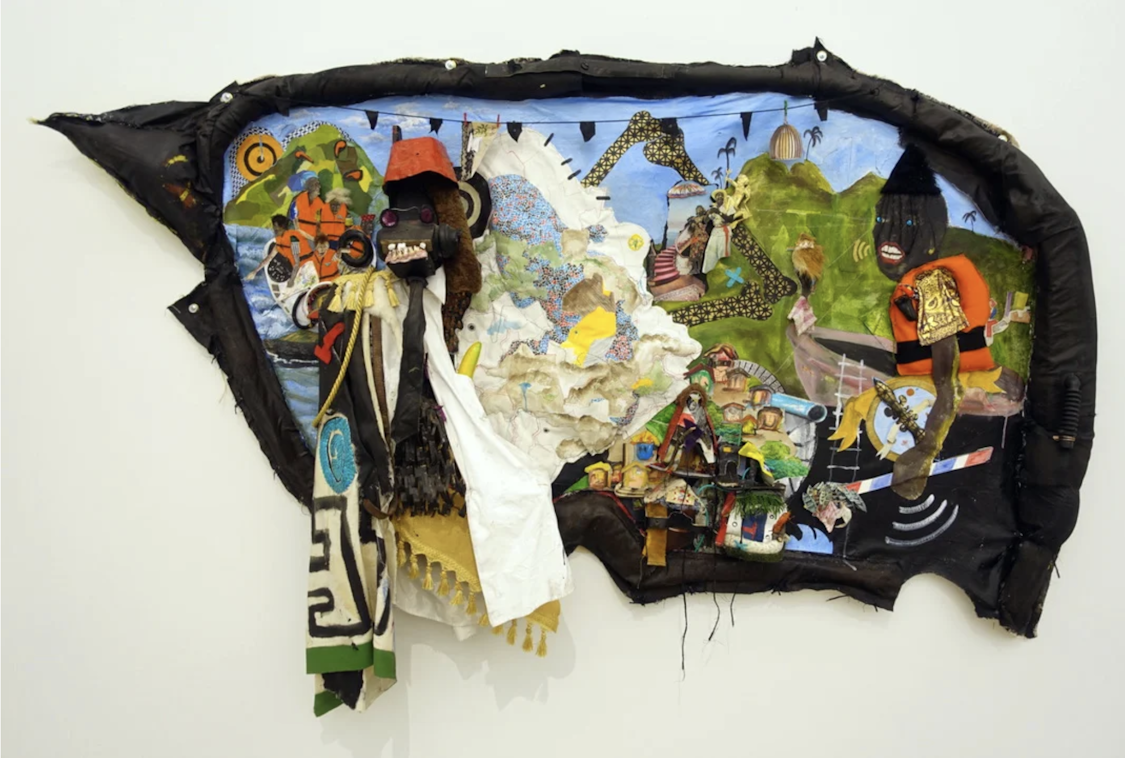
These questions are layered. If they do not all have to do with colonialism, they all relate to the specificity of a people, and to the knowledge that exists in a particular place. His answer made me wonder about the possibility of a world created out of all of these realities, a Caribbean epistemology, to ‘make world’?
It is funny you should ask. My work in the show ‘The Other side of Now’ imagines that space. I imagine that in the future there is a fracture, and the Caribbean plate breaks away. And it now rises up and all of the Caribbean islands that were separated by bodies of water and by bureaucracy are no longer separated and are reunited on one landmass. And as a result of this togetherness, there is this fusion over time of languages, so new languages develop, new folklore, customs, traditions, spiritual practices. New imagined space but with at the same time, the trauma of severe climate change, disaster is still present in the people. So many of them wear life vests, as symbols to always be prepared for a storm, or for flooding. Even though they are happy now, the trauma is still there. And the performance yesterday actually brought this landscape to life. We were in a location near the museum which is on uneven grounds, with hills, and coconut trees facing the water. It became the island.
In the end, he told me, he took the idea off the wall and brought it out into life into the public.
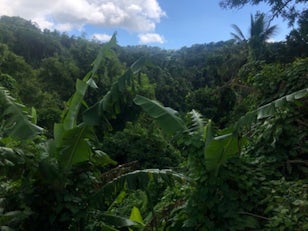
- Soufrière: Minia Biabiany
In November 2019, my PhD research led me to the Soufrière volcano in Guadeloupe. A boat ride away from Dominica. It was there that I met Minia Biabiany, who now divides her time between Mexico and Guadeloupe. 06 When in Guadeloupe, she lives in her family house in Saint-Claude, in the south of Basse-Terre. This is where we met. In this house, the house she grew up in, she works in a little studio, which opens into a hilly garden just down from the Soufrière, an active volcano that last erupted in 1976.
This is where she filmed the video for the work Toli Toli, which I saw at the 10th Berlin Biennale, ‘We don’t need another hero’, in July 2018. As Yvette Mutumba describes it: ‘Carrying throughout the installation Toli Toli (2018) in a revival of a forgotten past, elderly voices sing a song that was part of a traditional children’s game in rural parts of Basse-Terre, an island of Guadeloupe. In the game, a child would find a toli toli, a butterfly chrysalis the shape of a tiny finger, point it in a direction, and playfully imagine a distant or (un)known destination through the words of the song. Today, the children of Basse-Terre no longer know this song.’ 07
At the time we met, Minia had been working on a new project, J’ai tué le papillon dans mon oreille (‘I killed the butterfly in my ear’), which she saw as a continuation of Toli Toli. The house in which we spoke had been her grandfather’s house, where Toli Toli had been filmed.
I wanted to talk about the territory. I had not realised it was such a trendy subject at the moment, especially in France with the debates on the use of chlordecone. I never approach things in a straightforward way. I grew up in Saint Claude, opposite the Soufrière volcano. My grandfather was a farmer and my parents are people that have a specific link to the land. This link was not passed on to me, because we were in school and my parents did not want us to undertake that kind of hard work. There are a lot of things I did not have to do. I see this as a rupture. Just like with the creole language. There is the question of the link with the territory you grew up in, the question of the political tension with France, and with the fact that there is a forgetting of the knowledge and of the place, which are enduring at the same time. 08
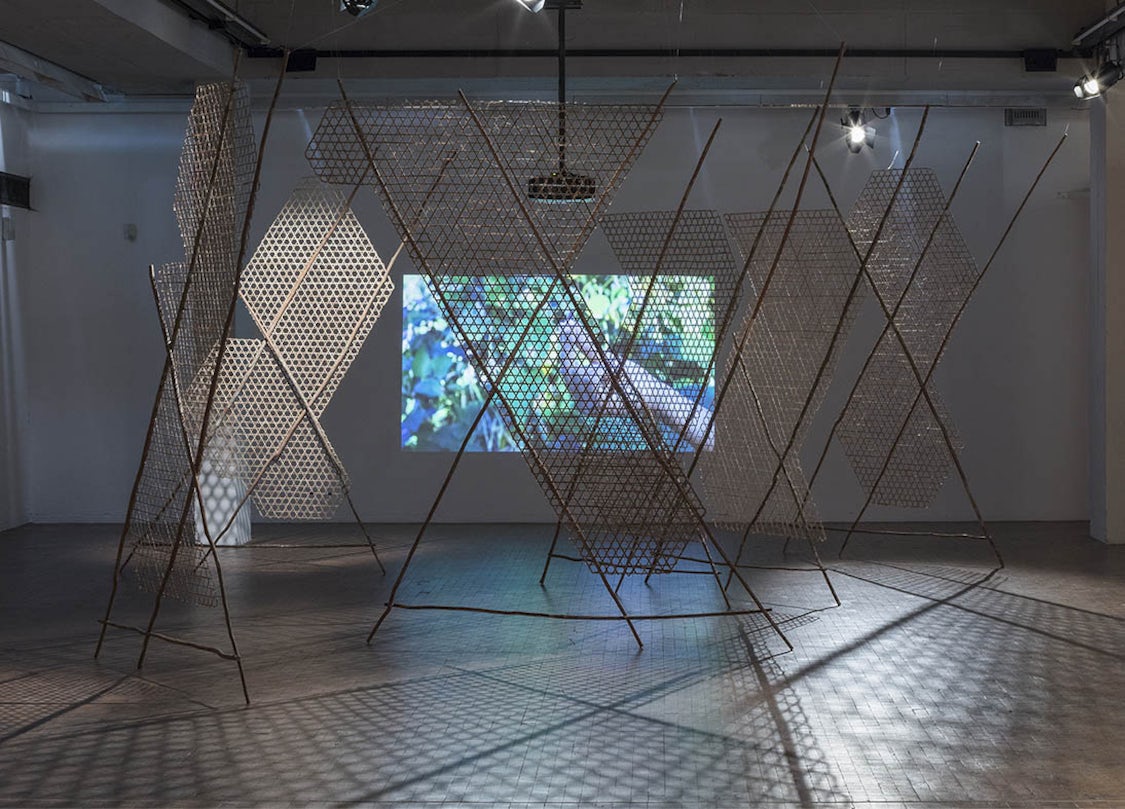
Minia’s grandfather was one starting point for this work. Although he lost his sight at a certain point in his life, he continued to care for his land. ‘I only every knew him blind, so I always witnessed his link to his surroundings through touch, through stroking.’ This suggests a consideration of blindness in two ways: the fact of no longer being able to see, and hence becoming cut off or removed from the world; but also blindness as a means towards discovery of other perceptions and relations to the world. Minia told me that although she always draws from the space she is exhibiting in, ‘now I am more interested in the phenomenology of the place, at the way light moves… very immediate things, that the body catches, and in turning them into something else.’ Minia explained to me that she wants to give strength to elements: to light, to the wind, to the breath of the volcano, and to learn to be in relation to all of this again, as a reaction to the rupture with the territory she identified. She often worked on creating connections between elements rather than on the elements themselves.
Minia added that she was now more interested in telling the story of the territory, and to give a voice to a territory whose specificity is made irrelevant. She contends that to see Guadeloupe as a faraway land that identifies with France in all respects; it does not align with the reality and the physical context that people experience.
I find this tension very interesting. It is a society of orality, where the Creole and the French are sometimes friends, sometimes enemies, sometimes blended, sometimes separated … There is a strength in what is spoken here. The spoken can also be feared: there are things that need to be said, and things that cannot be said. The relation to religion is also very specific. It is always hidden, by opposition to Haiti, even though there is also a very strong syncretism. My understanding of this is that it shapes a lot of the ways in which people interact with the place. If you authorise yourself to connect to a place through its strengths/forces, you have a much greater autonomy than if you always use the white Church as a reference point. This is a very interesting issue to me.
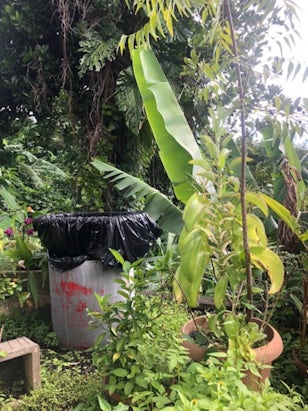
This was the first time Minia was working on a piece that directly comes out of another piece: J’ai tué le Papillon dans mon oreille is the sequel of Toli Toli, and just like in Toli Toli, she is still talking about narrative, about the importance of the voice of the territory, and about the link between narrative and weaving. It is a link that she is creating, but which exists in Mexico and in many other cultures.
The video of Toli Toli ends with a sentence: ‘the butterfly causes blindness when its wings in the ear’. It is a sentence, which, for me, alludes to the notion of passivity, to ‘not talk’, to not see a specific situation, without going as far as saying ‘we are alienated, we are sick’.
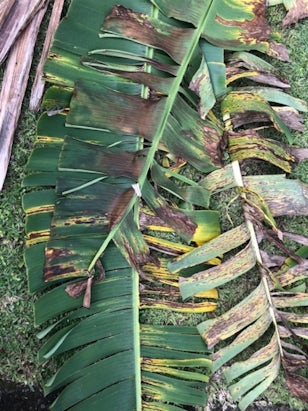
Minia showed me the Soufrière, and then she showed me a bucket.
This, is something I will do with my mother. I will fill up the bucket with water, stretch out a tarp. I want it to be a night scene, where she dips her face into the water. There are several scenes that I want to do with a body. I like that it is a mature woman, and not a younger body, with regards to the topic of the video. In the video, there will be shots that will show the river. And they will show diseased leaves.
The leaves suffer from what is called Cercosporiose (Mycosphaerella fijiensis), a leaf-spot disease of banana plants. The leaves turn yellow, photosynthesis is hampered and the bunches are smaller.

This one is an example of sooty mould (fumagine), that make the leaves look black. They are small organisms that colonise trees and suffocate them. Here you see a not so healthy soursop… The sooty mould is located under the tree, and arrives out of nowhere. Here, there were a lot of orange trees, and they all died within 10 years because of diseases. It is very common here in agriculture, it is a very difficult challenge. In the video, the disease will not directly have a voice, but it will be present in many shots. You can hear a river. I wanted there to be a raft made of leaves with cercosporiose, such as these. I wanted the raft to leave on the river, and to see a cutlass wrapped in the leaves. The video of Toli Toli is a weaving. The idea was to have a weaved narrative too: partially deconstructed, not at all linear.
It was quite complex to find out about the skills, and to find someone who would be able to teach me how to weave with bamboo. I finally found an elderly man in Vieux Fort, but he did not understand why a woman would want to learn how to do this. Because it is a fishermen’s tradition, and therefore reserved to men. So, in the end, I brought friends of mine. He would show them how to do it, and I would film it. And then I sat with my father, and watched the videos in slow motion, in order to learn the body movements. It was also an investigation as to when the bamboo had to be cut, because it is linked to moon phases. If you cut it at the wrong time, it gets eaten by worms very quickly.
Minia tells me that the resulting exhibition will address the poisoning of the earth, and of the forgetting of knowledge linked to the land. ‘I am from a generation, as I told you, who has trouble caring for the earth’. She is in a phase where she takes a lot of small bits of things here and there, always carrying her camera and ‘when I feel something poetic, even if I do not know why yet, I capture it, and then I edit it’. She spoke about using fishermen’s weavings to tell stories, ‘starting from our elements, without trying to reproduce external elements’. What she wants for the exhibition is to continue to work with narrative and weaving, but to make the forms into objects in relation with one another: to create encounters between objects, and have the visitors witness this encounter.

- Cold Soufriere: Belonging in Debris
In 2014 I finally made it to Dominica. I saw the ruins of the house my father grew up in in Clifton, and the deserted piece of land he inherited from his mother in Marigot. My aunt took me to the Cold Soufriere volcano in the north of the island, near where my father grew up. I covered my face with sulphur from the river, and thought about whether I would be a different person if I was able to do it every day. I knew I did not have long, so I kept looking at the boiling florescent puddles and taking photos of them on my iPhone.

In the end, promises of belonging always get shattered. I hate it when it hits me that the dream is over. What remains are the residues of short-lived, blissful illusions of coming together. As in any eruption, debris remain. To fully understand lost and non-lived memories feels out of reach, but to try to recover some of them somehow is understandable. This necessity to claim debris as belonging to my personal record takes roots in a longing for active linkage, a desire for perpetuation, and to bring them back to my shores is the only way for me to know the larger ensemble they belong to. To accept this limited window for knowledge just makes it acceptable that many ways of knowing are possible. Mine involves the investigation of a sea of debris, trying to make sense of them, and encountering people trying to do the same thing on the way.
What to do with debris depends on their state. Some obviously still carry the burning embers and toxic fumes of ongoing disaster. They are responsible for the limited economic opportunities available in Dominica, and for the ecological vulnerability of the island, which makes it unlikely that my family will ever reside there permanently again. The existence of places like the Cold Soufriere for them will only go on displaced. There might be more to say about the similarities between volcanic eruptions and hurricanes and how they relate to Caribbean history, as is suggested by the artist Deborah Jack. 09 If so, perhaps investigations into how to repair debris are as necessary as anything else. Both Minia and Nyugen want witnesses to their acts of repair to take part in it. The only way is to embrace the fragmentation, to exist within the tentativeness and fragility of ephemeral rafts like Nyugen’s bundlehouses. As Minia said, the most damaged branches of bamboo are the branches you need to weave. Living together through repair.
As for me, Dominica had been an image, and an impossibility. The fact is: things had been happening that I had not seen. Going there to study art meant collecting things that I had not lived. Collecting other peoples’ experience of the sounds, smells, textures, traumas, joys, hopes, desperation. I have been touched by efforts deployed by artists to think about the water between the islands as a link, and in this way, inhabiting the Atlantic distance means inhabiting a relation rather than a distance. It is probably the only viable way when you’ve grown up oceans apart. 10
Footnotes
-
‘Belle Ile en Mer, Marie-Galante, look alike.’ Laurent Voulzy Belle Ile en Mer – Marie Galante : https://www.youtube.com/watch?v=3C1AmVYiL0k&ab_channel=WildeTapes
-
Nyugen Smith, conversation with the author, 5 December 2019. Further quotations from the artist are taken from this conversation.
-
See https://scholarship.shu.edu/past-exhibits-2016/4/.
-
See https://upload.wikimedia.org/wikipedia/commons/9/98/Tropenmuseum_Royal_Tropical_Institute_Objectnumber_3626-1_Collage_van_17_tekeningen_en_aquarellen.jpg.
-
Tao Leigh Goffe, ‘Unmapping the Caribbean: Toward a Digital Praxis of Archipelagic Sounding’, archipelagos, issue 5, December 2020, available at http://archipelagosjournal.org/issue05/goffe-unmapping.html
-
Yvette Mutumba, ‘Minia Biabiany’, available at https://bb10.berlinbiennale.de/artists/m/minia-biabiany.
-
Minia Biabiany, conversation with the author, 29 November 2019. Further quotations from the artist are taken from this conversation.
-
I was introduced to Minia Biabiany in Paris by artist Julien Creuzet, while she was a resident at the Cité des Arts in 2013. Creuzet’s 2018 exhibition at Bétonsalon, entitled ‘La pluie a rendu cela possible depuis le morne en colère, la montagne est restée silencieuse. Des impacts de la guerre, des gouttes missile. Après tout cela, peut-être que le volcan protestera à son tour. – Toute la distance de la mer (…)’ (‘The rain made it possible, in the wake of the angry Morne, the mountain has been silent. Impacts of war, of missile drops. After all this, perhaps the volcano will protest in turn.—All the sea’s distance (…)’). In this exhibition, in which he is also talking about the Pelée volcano (‘In the wake of the angry Morne’) he attends the possibility of life after destruction.
-
See https://www.artsy.net/article/artsy-editorial-deborah-jacks-poetic-work-draws-parallels-hurricanes-caribbean-history.
-
See: http://www.ingridpollard.com/oceans-apart—seleceted-images.html.
